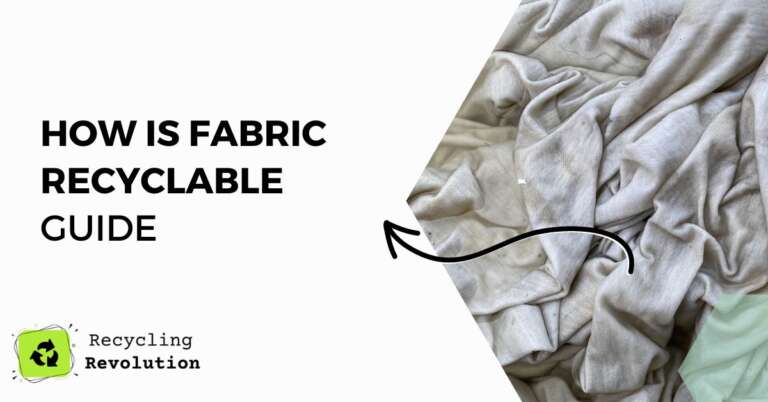Fabric is becoming a serious contender among other materials as the construction material of choice by architects, building officials, and waste management professionals.
While it once had a reputation of being an “easy” recyclable option, it turns out fabric is more complicated to recycle than initially thought.
What Fabrics Can Be Recycled
What fabrics can you take to the recycling facility? Here are a few ideas below, however, It’s important to note that not all types of fabric can be recycled, and some require special handling. Additionally, not all recycling facilities accept fabric, so it may be necessary to find a specific textile recycling program or facility in your area.
- Clothing (e.g. a shirt, pants, a dress)
- Linens (e.g. sheets, pillowcases, tablecloth)
- Towels (e.g. hand towels, bath towels, beach towels)
- Blankets (e.g. wool blanket, fleece blanket, electric blanket)
- Curtains (e.g. sheer curtains, blackout curtains, drapery panels)
- Carpets (e.g. area rugs, wall-to-wall carpets, stair carpets)
- Rugs (e.g. kitchen rug, door mat, bath mat)
- Upholstery fabric (e.g. couch cushion, armchair, ottoman)
- Denim(e.g. Jeans, denim jacket, denim skirt)
- Bags (e.g. tote bags, duffle bags, backpack)
- Scraps of fabric (e.g. small pieces of fabric from a sewing project, fabric remnants, fabric swatches)
Fabric is a textile material made from yarn or thread. Yarns are produced from a variety of natural and synthetic fibers. The most common fibers are cotton, wool, nylon, polyester, and silk. Naturally occurring fabrics include linen, hemp, and ramie. Other non-naturally occurring fabrics include viscose rayon, acetate, modal, and lyocell.
There are two types of fabric: woven and nonwoven. Woven fabrics can be further subdivided into plain weaves (where one thread crosses over another) and twills (where two lines cross over each other). To create a solid structural material, nonwoven fabrics bond fibers or filaments at high temperatures.
Why Recycle, Reuse and upcycle Fabric
Recycling, reusing, and upcycling fabric can have a positive impact on the environment by reducing the amount of waste and pollution caused by the textile industry. Here is a brief explanation of each concept:
- Recycling: Fabric recycling is the process of breaking down used textiles into raw materials, which are then used to create new products. This reduces the need for virgin materials and reduces the amount of waste sent to landfills.
- Reusing: Reusing fabric means using it for the same purpose multiple times before disposing of it. This can include wearing clothes multiple times before washing them or repurposing an old shirt into a rag. This also helps to reduce the amount of waste and the need for new materials.
- Upcycling: Upcycling is a form of recycling where old or used materials are repurposed into new products of higher value. It’s a way to give new life to a product and material that would otherwise be discarded. This also helps to reduce the amount of waste, as well as consumption of raw materials
The textile industry is a major contributor to waste and pollution, due to the high consumption of resources and energy required to produce new textiles. Additionally, many clothes and textiles end up in landfills, where they can take decades to decompose, releasing harmful chemicals and greenhouse gases into the environment. By recycling, reusing, and upcycling fabric, we can reduce the environmental impact of the textile industry, while also conserving resources and reducing waste.
How Can You Recycle Fabrics?
There are a few methods if you have an old garment or blanket that you’d like to recycle.
Donate
Most Americans who want to organize their closets frequently end up giving away or selling any usable items they discover. Most cities have organizations like The Epilepsy Foundation or Goodwill-Easter Seals, enabling residents to donate their old clothing.
Some organizations sort donated goods and resell them in their shops, while others market the textiles to processing businesses to make money. In nations plagued by poverty, goods that are not appropriate for sale may be helpful.
Re-using
There might still be some life in the fibers of worn-out, soiled, or otherwise unwearable fabric objects. When divided into squares, old towels make excellent cleaning rags, and an oversized, damaged shirt comes in handy when painting or engaging in other filthy hobbies.
Even worn-out denim can be made into a nice snack bag or a soft baby book. Before you throw away fabric, consider these creative uses for leftover fabrics featured in this Good Housekeeping article. If you involve your family, you will set an example of sustainability and inventiveness.
Recycling
Although it may seem strange, many fabrics can be recycled. A nonprofit group called the Council for Textile Recycling (CTR) works to prevent textiles like clothing, shoes, and other materials from ending up in landfills. By 2037, the association wants to eliminate all textile waste from landfills.
It requires a lot of work to bring the issue to light and link cities with fabric recyclers. Due to the growing awareness of the benefits of textile recycling, more towns are starting to permit the disposal of fabric materials in the blue bin alongside glass jars and plastic milk jugs. Like other recycling processes, textiles are separated by kind before being used for another purpose.
This infographic demonstrates where recycled products wind up; approximately half of the clothing, shoes, and other materials are shipped abroad to aid people in need. The remaining material is shredded with different fibers to make new products like carpet padding and house insulation. Only 5% of the recycled fabrics are left over at the end.
Fabrics Recycling Law Safety and Legislation
Laws and legislation regarding the recycling of fabrics vary by location. In some areas, specific laws or regulations may govern the recycling of certain materials or the proper disposal of textiles. In other areas, there may be no specific laws or rules, but incentives or programs may be in place to encourage the recycling of fabrics.
In the United States, the Environmental Protection Agency (EPA) has set a goal to recycle or reuse at least 15% of all discarded textiles by 2030. However, no federal laws in the US specifically require the recycling of fabrics. Instead, the responsibility for managing and regulating textile recycling falls to individual states and local governments.
Some states have implemented laws or programs to encourage the recycling of textiles. For example, California has a law requiring retailers to accept and recycle used clothing, shoes, and other materials, and some cities in the state have implemented similar programs. Other states, such as Massachusetts and Rhode Island, have implemented deposit-refund systems for certain textiles, identical to bottle and can deposit programs.
In other countries, specific laws or regulations may govern the recycling of fabrics. For example, the European Union has implemented several measures to promote the reuse and recycling of textiles, including mandatory labeling requirements and targets for recycling certain types of fabrics.
If you are interested in recycling fabrics in your area, check with your local government or recycling center to find out any specific laws or regulations that may apply.
Frequently Asked Questions
Are there any environmental benefits to fabric recycling?
Yes, there are several environmental benefits to fabric recycling. Recycling fabrics conserves resources, reduces the demand for virgin materials, and reduces the amount of waste sent to landfills. Fabric recycling can also help reduce greenhouse gas emissions, as new fabrics often involve energy-intensive processes.
What types of fabrics can be recycled?
Most natural fibers, such as cotton, linen, and wool can be recycled
. Synthetic fibers, such as polyester and nylon, can be recycled, although the recycling process may be more complex. Some fabrics, such as leather and fur coats, are more challenging to recycle and may only be accepted at some recycling facilities.
How do I prepare fabrics for recycling?
To prepare fabrics for recycling, you should first sort them by material type and color. Then, you should remove any non-fabric items, such as buttons or zippers, and cut the fabrics into small, manageable pieces. It is also a good idea to clean the fabrics, as dirty or soiled fabrics may not be accepted at recycling facilities.
Conclusion
Choosing how to handle your torn or damaged garments will depend on your preference. Some people are repulsed by putting a worn item in with the rest of their clean clothes, while others might not mind. For those that don’t follow, clothing recycling centers can be an excellent resource for giving old garments a new purpose.

